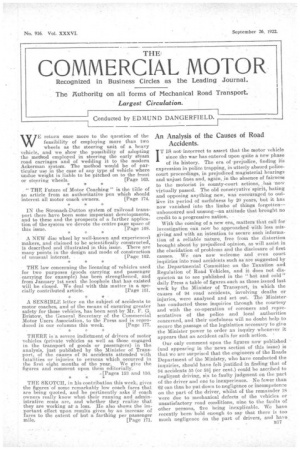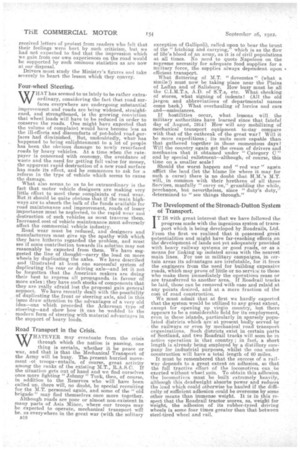An Analysis of the Causes of Road Accidents.
Page 1

Page 2

If you've noticed an error in this article please click here to report it so we can fix it.
IT IS not incorrect to assert that the motor vehicle since the war has entered upon quite a new phase of its history. The era of 'prejudice, finding its expression in !Mae trapping, in utterly absurd policecourt proceedings, in prejudiced magisterial hearings and unjust fines and, again, in the absence of fairness to the motorist in county-court actions, , has now virtually passed. The old conseryative spirit, hating and opposing anything new, was encouraged to outlive its period of usefulness by 20 years, but it has now vanished into the limbo of things forgotten-unhonoured and unsung—an attitude that brought no credit to a. progressive natioe.
With the coming of a new era, matters that call for investigation can now be approached with less misgiving and with an. intention to secure such information of a reliable nature, free from the distortion brought about by prejudiced opinion, as will assist in the elucidation of problems and the disclosure of first causes. . We can now welcome and .even court inquiries into road accidents such as are suggested by the Departmental Committee on the Taxation and Regulation of Road Vehicles, and it does not disquieten us to see published in the " hot and cold" daily Press a table of figures such as those issued last week by the Minister of Transport, in which the causes of 94 road accidents, involving deaths or injuries, were analysed and set out. The Minister. has conducted these inquiries through the courtesy and with the co-operation of coroners and representatives of the police and local authorities concerned, and their usefulness will no doubt help to seaure the passage of the legislation necessary to give the Minister power to order an inquiry whenever it appears that an accident calls for suchaction. '
Our only comment upon the figures now published (and appearing in the section of this issue) is that we are surprised that the engineers of the Roads Department of the Ministry, who have conducted the inquiries, should have felt justified in finding that of 94 accidents 55 (or 58 Per cent.) could be ascribed to negligent driving, six to faulty judgment on the part of the driver and one to inexperience. No fewer than 62 can thus be put down to negligence or incompetence on the part of the driver, whilst of the remainder 16 were due to mechanical defects of the vehicles or unsatisfactory road conditions, nine to the faults of other persons, five being inexplicable. We have recently been bold enough to say that there is too much negligence On the part of drivers, and have received letters of protest from readers who felt that their feelings were hurt by such criticism, but we had not expected to find that the impression which we gain from our own experiences on the road would be supported by such ominous statistics as are now at our disposal. . Drivers must study the Ministry's figures and take severely to heart the lesson which they convey.
Four-wheel Steering.
WHAT has seemed to us lately to be rather extraordinary, considering the fact that road surfaces everywhere are undergoing substantial improvement and roads are being widened, straightened, and strengthened, is the growing conviction that wheel loads will have to be reducedin order to conserve the roads. One might have expected that the volume of complaint would have become less as the ill-effects and discomforts of pot-holed road qmrfaces had diminished. But, undoubtedly, what. has happened to bring enlightenment to a lot of people has been the obvious damage to newly resurfaced roads by heavy vehicles. At a time -when the ratepayer is concerned with economy, the avoidance of waste and the need for getting full value for money, the apparent rapid destruction of a new road surface has made its effect, and he commences to ask for a reform in the type of vehicle which seems to cause the damage.
What also seems,to us to be extraordinary is the fact that motor vehicle designers are making very little effort to meet these complaints of road wear. But it should be quite obvious that if the main highways are to absorb the bulk of the funds available for road maintenance and improvement, roads of lesser importance must, be neglected, to the rapid wear and destruction of such vehicles as must traverse them. Increased cost of vehicle maintenance must adversely affect the commercial vehicle industry. Road wear must be reduced, and designers and manufacturers must give up the apathy with which they have hitherto regarded the problem, and must see if some contribution towards its solution may not reasonably be expected from them. We have suggested the line of thought—carry the load on more wheels by duplicating the axles. We have described and illustrated at least one successful system of duplicating the rear or driving axle—and let it not be forgotten that the American makers are doing their best to repress all propaganda in favour of more axles ; they have such stocks of components that they are really afraid lest the proposal gain general support.. We have recently dealt with the possibility of duplicating the front or steering axle, and in this issue draw attention to the advantages of a very old idea—one which preceded the Ackerman type of steering—and show' how it can be wedded to the modern form of steering with material advantages in the support of heavy loads. _ Road Transport in the Crisis.
WHATEVER may eventuate from the crisis through which the nation is passing, one thing is certain, whether it be peace or war, and that is that the Meohanical Transport of the Army will be busy. The present hurried movement -of troops-entails, of course, great activity among the ranks of the existing M.T., R.A.S.C. If the situation gets out of hand and we find ourselves once more fighting " Johnny " Turk, then, of course, in addition to the Reserves who will have been called up, there will, no doubt, be special recruiting for the M.T. personnel again, and some of the "old brigade" may find themselves once more together.
Although roads are poor or almost non-existent in many parts of Asia Minor, where our troops may be expected to operate, mechanical transport will be, as everywhere in the great war (with the solitary B18 September 26, 1922. exception of Gallipoli), called upon to bear the brunt of the "fetching and carrying, which is as the flaw of life's blood of an army, as it is of civil populations at all times. No need to quote Napoleon on the supreme necessity for adequate food supplies for a military force, the supplies always dependent upon • efficient transport.
What fluttering of M.T. "dovecotes " (what a simile I) must now be taking place near the Plains of Laffan and of Salisbury.. How busy must be all the C.I.M.T.s, A.D. of S.T.s:, etc. What checking of stores, what signing of indents! (All the old jargon and abbreviations of departmental names come back.) What overhauling of lorries and cars and—ambulances.
If hostilities occur, what lessons will the military authorities have learned since that fateful day of August, 1914? How will any mobilizing of mechanical transport equipment to-day compare with that of the outbreak of the great war? Will it be more expeditious ; its units more capable than that gathered together in those momentous days? Will the country again get the cream of drivers and mechanics that it obtained under "Category C" and by special enlistment—although, of course, this time on a smaller scale?
Shouldthe worst happen and "red war" again afflict the land (let the blame lie where it may for such a curse) there is no doubt that H.M.'s M.T. will, in common with their brethren of all three Services, manfully "carry on," grumbling the while, perchance, but nevertheless, since " duty's duty," determined to ".me things through."
The Development of the Stronach-Dutton System of Transport. •
IT IS with great interest that we have followed the progress made with the ingenious system of transport which is being developed by Roadrails, Ltd. From the first we realized that it possessed great potentialities and might have far-reaching effects on the development of lands not yet adequately provided with heavy railway systems or good roads, or as a means for linking up isolated areas with the nearest main lines. For use in military campaigns, in certain areas its advantages are irrefutable, for it frees the engineers from the need for building expensive roads, which may prove of little or no servie to those who make them immediately the operations cease or are transferred to another area. if Roadrail tracks be laid, those can be removed -with ease and relaid at any points desired, and at a mere fraction of the cast of road construction.
We must admit that at first we hardly expected that the system would be utilized to any great extent, except for opening up virgin country, but there appears to be a considerable field for its employment, even in these islands, particularly in sparsely populated districts which are at present badly served by the railways or even by mechanical road transport organizations. Such districts exist in certain parts of Scotland, and two Roadrail tracks will soon be in active operation in that country • in fact, a short length is already being employed by a distillery corn.: pany for industrial purposes, whilst the one under construction will have a total length of 60 miles. It must he remembered that the success of a railway depends to a great extent on adhesion, so that the full tractive effort of the locomotives can be exerted without wheel spin. To obtain this. adhesion the locomotives must be built extremely heavily, although this deadweight absorbs power and reduces the load which could otherwise be hauled if the difficulty of sufficient adhesion could be overcome by some other meats than immense weight. It is in this respect that the Roadrail tractor scores, as, weight for weight, the adhesion of its rubber-tyred driving wheels is some four times greater than that between steel-tired wheel and rail.




























